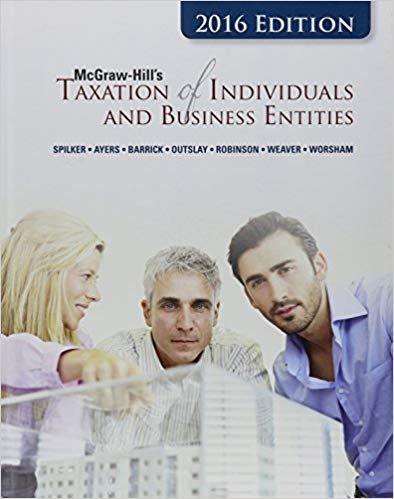12 In 2019, Tom and Amanda Jackson (married filing jointly) have $200,000 of taxable income before considering the following events: (Use the dividends and capital gains tax rates and tax rate schedules.) points Skipped eBook a. On May 12, 2019, they sold a painting (art) for $110,000 that was inherited from Grandma on July 23, 2017. The fair market value on the date of Grandma's death was $90,000 and Grandma's adjusted basis of the painting was $25,000. b. They applied a long-term capital loss carryover from 2018 of $10,000. c. They recognized a $12,000 loss on the 11/1/2019 sale of bonds (acquired on 5/12/2009). d. They recognized a $4,000 gain on the 12/12/2019 sale of IBM stock (acquired on 2/5/2019) e. They recognized a $17,000 gain on the 10/17/2019 sale of rental property (the only 51231 transaction) of which $8,000 is reportable as gain subject to the 25 percent maximum rate and the remaining $9,000 is subject to the 0/15/20 percent maximum rates (the property was acquired on 8/2/2013). f. They recognized a $12,000 loss on the 12/20/2019 sale of bonds (acquired on 1/18/2019). g. They recognized a $7,000 gain on the 6/27/2019 sale of BH stock (acquired on 7/30/2010). h. They recognized an $11,000 loss on the 6/13/2019 sale of QuikCo stock (acquired on 3/20/2012) 1. They received $500 of qualified dividends on 7/15/2019. Hint Print After completing the required capital gains netting procedures, what will be the Jacksons 2019 tax liability? (Do not round intermediate calculations.) References Total tax liability Tax Rates for Net Capital Gains and Qualified Dividends Taxable Income Rate Married Filing Jointly Married Filing Separately Single Head of Household 06 $0 $78,750 $0 - $39,375 $0 - $39,375 50 - $52,750 15% $78,751 - $488,850 $39,376 - $244.425 $39,376 - $434,550 $51,751 - $461,700 20% S4R8 851+ $244 426+ $434,551+ $461,701+ *This rate applies to the nel capital gains and qualified dividends that fall within the range of taxable income specified in the table $0 $2,650 $2,651 - $12.950 $12.951+ et capital gains and qualified dividends an 2019 Tax Rate Schedules ndividuals Schedule X-Single If taxable income is over: But not over: The tax is: $ 0 $ 9,700 10% of taxable income $ 9,700 $ 39,475 $970 plus 12% of the excess over $9,700 $ 39,475 $ 84,200 $4,543 plus 22% of the excess over $39,475 $ 84,200 $160,725 $14,382.50 plus 24% of the excess over $84,200 $160,725 $204,100 $32,748.50 plus 32% of the excess over $160,725 $204,100 $510,300 $46,628.50 plus 35% of the excess over $204,100 $510,300 $153,798,50 plus 37% of the excess over $510,300 Schedule Y-1-Married Filing Jointly or Qualifying Widow(er) If taxable income is over: But not over: The tax is: $ 0 $ 19,400 10% of taxable income $ 19,400 $ 78,950 $1,940 plus 12% of the excess over $19,400 $ 78,950 $168,400 $9,086 plus 22% of the excess over $78,950 $168,400 $321,450 $28,765 plus 24% of the excess over $168,400 $321.450 $408,200 $65,497 plus 32% of the excess over $321,450 $408,200 $612,350 $93,257 plus 35% of the excess over $408,200 $612,350 - $164,709.50 plus 37% of the excess over $612,350 The tax is: Schedule Z-Head of Household If taxable income is over: But not over: $ 0 $ 13,850 $ 13,850 $ 52,850 $ 52,850 $ 84,200 $ 84,200 $160,700 $160,700 $204,100 10% of taxable income $1,385 plus 12% of the excess over $13,850 $6,065 plus 22% of the excess over $52,8501 $12.962 plus 24% of the excess over $84.200 $31,322 plus 32% of the excess over $160,700 chedule Z-Head of Household If taxable income is over: But not over: $ 0 $ 13,850 $ 13,850 $ 52,850 $ 52,850 $ 84,200 $ 84,200 $160,700 $160,700 $204,100 $204,100 $510,300 $510,300 The tax is: 10% of taxable income $1,385 plus 12% of the excess over $13,850 $6,065 plus 22% of the excess over $52,850 $12.962 plus 24% of the excess over $84,200 $31,322 plus 32% of the excess over $160,700 $45,210 plus 35% of the excess over $204,100 $152,380 plus 37% of the excess over $510,300 Schedule Y-2-Married Filing Separately If taxable income is over: But not over: $ 0 $ 9,700 $ 9,700 $ 39,475 $ 39,475 $ 84,200 $ 84,200 $160,725 $160,725 $204,100 $204,100 $306,175 S306.175 The tax is: 10% of taxable income $970 plus 12% of the excess over $9,700 $4,543 plus 22% of the excess over $39.475 $14,382 50 plus 24% of the excess over $84,200 $32,748,50 plus 32% of the excess over $160,725 $46,628.50 plus 35% of the excess over $204,100 $82,354 75 plus 37% of the excess over $306,175










